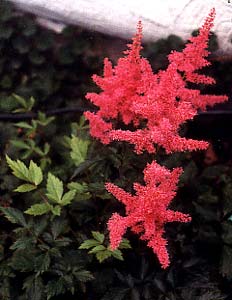
Astilbe 'Bremen' & 'Pumila'
Two False Spireas
"I dream'd I lay where flowers were springing
Gaily in the sunny beam."
-Robert Burns
(1759-1796)
(1759-1796)
I'm not usually much of a fan of astilbe. There are numerous species with many, many varieties & the flowers of most of them are showy & suited to bouquets, with the finely cut fern-like leaves eye-catching. But it nevertheless often seems to me to be a scruffy or too-ordinary perennial of only moderate interest. Strictly a matter of taste; astilbe's are popular without requiring my recommendation.
In spite of tepid feelings toward astilbe, I planted a couple of them behind the Black Swan Beech where they have flourished without much attention or care. The photograph above shows the bright feathery deep dark rosy pink plume in early July (it is dried out by mid-July & should be deadheaded if there is any chance of another bloom in August). Because the cotton-candy bloom is very transient in the garden, some have recommended leaving the plumes on even when they turn brown, as they will still have some decorative value as winter approaches. I don't personally find the dead panicles all that decorative.
Though almost always listed as A. japonica, this is to large extent a commercial name for a cluster of hybrids that are actually Astilbe x arendsii. It does well in partial shade, can be drought tolerant to a degree though it prefers moist loamy soil; & is usually a little less than two feet tall. Astilbe is shallowly rooted & benefits from winter mulching if there are extended days below freezing.
The other astilbe growing near the 'Bremen' is Astilbe chinensis var. pumila which is a "botonical" or naturally occuring dwarf form of the Chinese Astilbe, often sold as if the variant name 'Pumila' is a cultivar name.
This is my favorite astilbe by far, but I failed to get a good portrait of it this year, so will have to try to be more on top of that when it blooms next year. A late-blooming astilbe, it is at its height of glory in August & through part of September, blooms occasionally still showing color in October. 'Pumila' flowers with slender pink-violet sentries, rather than big fluffy cotton-candies like the 'Bremen.' As a dwarf it is a scant eight to ten inches tall, a whole foot including the lilac-pink flower spikes. I got mine from the edge of a thick stand growing on a friendly landscaper's road's edge garden, a many-years-old colony the center of which was taller than the usual maximum. It really looked great in a colony so I hope mine does spread.
It likes the sun but a little protection during the hottest months is also wanted. It should eventually form large clumps that spread surprisingly fast (faster than any of the larger Chinese Astilbe varieties). It can be dug up & divided once every few years; or to avoid disrupting the entire colony it can be thinned down by digging out rooted starts.
Dwarf Chinese Astilbe does not fair well in alkaline soil but wants rich loamy acidic moist soils. Though it is more drought tolerant than the majority of astilbes, it is best not to test the limits, so keep the soil moist, or leaves may brown at the height of summer. I think it makes for a more pleasant groundcover if the spent flowerheads are removed. But deadheading won't increase the likelihood of rebloom, so any gardener who finds the dried flowerheads attractive may wish to leave them, as they can last through most of the winter.